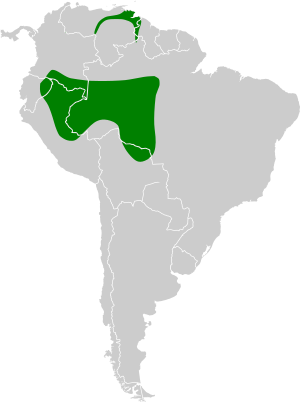Velvet-fronted grackle facts for kids
Quick facts for kids Velvet-fronted grackle |
|
|---|---|
| Conservation status | |
| Scientific classification | |
| Genus: |
Lampropsar
|
| Species: |
tanagrinus
|
 |
|
The velvet-fronted grackle (Lampropsar tanagrinus) is a type of bird found in parts of South America. It belongs to the Icteridae family, which includes many well-known birds like orioles and blackbirds. This bird is special because it's the only species in its group, called Lampropsar.
You can find the velvet-fronted grackle in countries like Bolivia, Brazil, Colombia, Ecuador, Guyana, Peru, and Venezuela. It likes to live in warm, wet places such as tropical swamps and forests that have been changed by people.
Contents
What Does the Velvet-Fronted Grackle Look Like?
The velvet-fronted grackle is an all-black bird. Both males and females have a slightly shiny, bluish look on their backs. The males are a bit bigger, growing to about 22 centimeters (8.7 inches) long. The females are around 19 centimeters (7.5 inches) long.
Unique Features of This Bird
One cool thing about this bird is its name! The feathers right at the front of its head are very short and thick. This makes them look and feel like soft velvet if you see them up close. Its beak is short and pointy, shaped like a cone. It also has dark eyes and a long, somewhat rounded tail.
Sounds and Calls
These grackles make different sounds. You might hear a crackling "chack" or a whistling "cheziit." Sometimes, especially in the evening, they sing a song that sounds like a fast, gurgling tune. It's quite musical!
Where Do Velvet-Fronted Grackles Live?
The velvet-fronted grackle lives in two main areas. One group is found in Venezuela and Guyana. The other group lives further south, in southern Colombia, eastern Ecuador, northern Peru, western Brazil, and northern and central Bolivia.
Preferred Habitats
These birds love places that get flooded sometimes, like várzea forests. They also enjoy living at the edges of forests and in swamps near ponds, rivers, and lakes. These wet environments provide them with food and shelter.
How Do Velvet-Fronted Grackles Behave?
Velvet-fronted grackles often hang out together in small groups. These groups can have up to about twenty birds. Sometimes, they even join up with other types of birds, like tanagers and caciques.
Foraging and Diet
These birds are quite active. They move noisily through the treetops, looking for food both high up and closer to the ground. You might even see them hopping around on plants floating on lakes! Their diet includes insects like winged ants and beetles, but scientists are still learning more about what they eat.
Reproduction and Breeding Season
The breeding season for velvet-fronted grackles varies depending on where they live. In Guyana, they breed in March. In Ecuador, it's in September. And in Bolivia, they breed in October and February.
Is the Velvet-Fronted Grackle Endangered?
The International Union for Conservation of Nature (IUCN) has looked at the velvet-fronted grackle. They have classified it as a species of "least concern." This means that scientists are not worried about this bird becoming endangered right now.
Population and Range
There are a few reasons why it's not a concern. The bird lives across a very large area, covering about 2,420,000 square kilometers (934,000 square miles). Its population is also believed to be stable, and it's fairly common to see. Experts estimate there are over 10,000 adult velvet-fronted grackles in the world.
Images for kids
See also
 In Spanish: Turpial de frente terciopelo para niños
In Spanish: Turpial de frente terciopelo para niños



